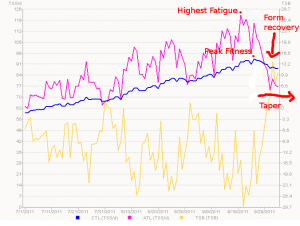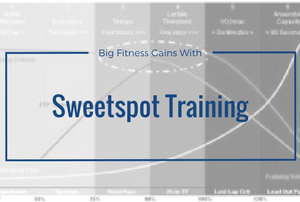Since most of us are in the build phases of our training plans, anticipating early season racing and getting psyched up for our early season goals, you may be wanting to boost your fitness a little more. If you're finding that you're just a little behind the curve, it may be time to consider adding a little “Sweet Spot Training (SST)” in your routine to prod your body up to the next level. But what is SST? How do you do it? How much is too much? How does it actually make you stronger and faster? I'll explain what it is and how you do it after the jump.
 What is Sweet Spot Training?
What is Sweet Spot Training?
SST is basically a term for a type of training that relates to a finely balanced amount of intensity and volume.
So what is that in layman's terms?
Let's back up a moment: The purpose of training is to create physiological adaptation in the body. We do this by performing a variety of workouts, from aerobic work to threshold work and interval training. While it would be nice to be able to train 20 hours per week, most of us have various parts of our lives that take precedence (work, kids, home ownership, etc) and limit us to fewer training hours. This is where SST can be of immeasurable value, if it's executed properly.
So for example, instead of doing several hours of aerobic training and numbers of intervals, SST is one of the best “bang for your buck” training methods. It doesn't necessarily replace intervals or aerobic riding. Essentially, it gives you the best of both worlds: some of the benefits of both long tempo miles and short hard intervals. It is also one of the fastest ways to raise your threshold power, which is the key to riding hard with the peloton, with your buddies on a group ride or on your own for any extended period of time. With appropriate application of SST, you'll be able to put the screws to the Saturday group ride, hang with the peloton and finish strong on your solo rides. Imagine all this with between 30 minute and 2 hour workouts?
It Can Be Done!
 It can be done because SST elicits more adaptations than tempo workouts but less than threshold work or interval training. Sure, it sits right in between no-man's-land and all out war, but that's the beauty of it. Each day an athlete engaged in SST can absorb more physiological stress than if they performed the equivalent volume of threshold or interval work by maximizing their recovery time (and it simply causes more adaptation than aerobic work in a shorter time frame.) The balance comes into play when the athlete can repeat and achieve similar wattages and heart rates day after day with greater frequency than that allowed by interval or threshold work, and they are able to recover properly in between intervals.
It can be done because SST elicits more adaptations than tempo workouts but less than threshold work or interval training. Sure, it sits right in between no-man's-land and all out war, but that's the beauty of it. Each day an athlete engaged in SST can absorb more physiological stress than if they performed the equivalent volume of threshold or interval work by maximizing their recovery time (and it simply causes more adaptation than aerobic work in a shorter time frame.) The balance comes into play when the athlete can repeat and achieve similar wattages and heart rates day after day with greater frequency than that allowed by interval or threshold work, and they are able to recover properly in between intervals.
Whereas you may need a full day of recovery after a high intensity interval type workout, I find that athletes can typically perform several days of sweet spot training in a row without needing significant time off the bike. This means an increase in volume (one of the main training metrics) without burning down the athlete.
How Do You Do It?
If training with power, you'll want to do intervals of 15-20 minutes at 91-95% of your FTP (functional threshold power.) For heart rate training, shoot for the same duration at 90-95% of your lactate threshold heart rate. The beauty of sweet spot training is that you can work it into your weekly ritual easily. You can do sweet spot training on the weekly group ride (stay on the front longer, go on a solo flier, drop off the back and catch back on,) you can go for a nice mountain bike ride (ride hard and fast, but still have fun with it) or pick a day and ride with someone stronger than you (if you're a woman, ride with the guys; if you're a cat 5, ride with the 3s…)
That's the joy of sweet spot training…you can have a blast with your buddies and still gain a boatload of fitness at the same time. So think about incorporating it into your buildup, and you'll see benefits before you know it.
Questions? Post 'em up and get the discussion rolling.

going to link to this on my indoor cycling page at http://www.indoorcyclingmixes.com – thinking how to build this into spinning classes
Hey Matthew,
That sounds pretty cool. I wonder if you can use it during rest periods between higher intensity intervals?